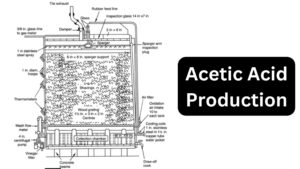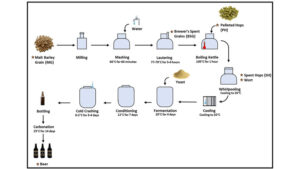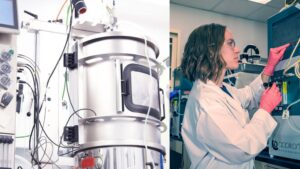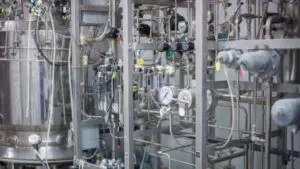What is an Industrial centrifuge?
An industrial centrifuge is a machine that uses centrifugal force to separate or purify materials. Centrifuges work by spinning a sample at high speeds, using gravitational force to separate the components of the sample based on their density, size, or shape. Industrial centrifuges can be used for a wide range of applications, including separating liquids and solids, purifying substances, and separating mixtures based on their properties. There are several types of industrial centrifuges, including decanter centrifuges, filter centrifuges, and sedimentation centrifuges. They are used in a variety of industries, including chemical, pharmaceutical, food processing, and environmental engineering.
Features of Industrial centrifuge
Some common features of industrial centrifuges include:
- High speed: Industrial centrifuges operate at high speeds, typically ranging from several hundred to several thousand revolutions per minute (RPM). This high speed generates the centrifugal force that is used to separate the substances.
- Variable speed: Many industrial centrifuges have variable speed control, allowing the operator to adjust the speed of the centrifuge based on the specific separation needs.
- Automatic balancing: Some industrial centrifuges have automatic balancing systems that help to maintain a stable and balanced load during operation. This can help to improve the separation efficiency and reduce the risk of mechanical failure.
- Self-cleaning: Some industrial centrifuges have self-cleaning features, such as automatic wash cycles, to help ensure that the centrifuge is kept clean and free of contamination.
- Safety features: Industrial centrifuges may include safety features such as emergency stop buttons, safety interlocks, and other safety devices to protect the operator and the equipment.
- Control panel: Most industrial centrifuges have a control panel that allows the operator to control and monitor the operation of the centrifuge. The control panel may include buttons, switches, and displays for setting the speed, timing the separation process, and monitoring the operation of the centrifuge.
Types of Industrial centrifuge
There are two primary categories of industrial centrifuges: filtration and sedimentation.
1. Filtration
A filtration centrifuge employs a revolving basket with small apertures that permit liquid to pass through but retain particles. There are numerous types of filtering centrifuges, including:
- Perforate Basket Centrifuge
- Pusher Centrifugal Centrifuge
- Peeler Centrifuge
2. Sedimentation
In contrast to the filtration centrifuge, the sedimentation centrifuge is a closed bowl. Utilizing centrifugal force, the solids collect along the bowl’s wall, while the liquid separates from the solid. After liquid and solids are separated, the liquid escapes through an outlet passage. There are numerous types of sedimentation centrifuges, including:
- Disgorgement Centrifugation
- Disk-stack Centrifuge
- Solid-bowl Basket Centrifuge
- Tubular Bowl Centrifuge
Parts of Industrial centrifuge
An industrial centrifuge is a mechanical device that uses centrifugal force to separate substances of different densities. It consists of a rotating drum or bowl that is driven by a motor, and it is used in a wide range of industries, including pharmaceuticals, chemical processing, food and beverage, and oil and gas.
The main parts of an industrial centrifuge include:
- The drive system: This consists of a motor and transmission system that rotates the drum or bowl at high speeds.
- The drum or bowl: This is the main component of the centrifuge, and it is where the separation takes place. The drum or bowl is typically made of stainless steel or another corrosion-resistant material.
- The feed system: This is used to introduce the material to be separated into the centrifuge. It may consist of a feed pipe, feed valve, or other feeding mechanism.
- The separation system: This is the part of the centrifuge that separates the different substances based on their densities. It may include screens, filters, or other separating mechanisms.
- The discharge system: This is used to remove the separated materials from the centrifuge. It may include a discharge valve or other discharge mechanism.
- The control system: This is the part of the centrifuge that controls its operation, including the speed and duration of the separation process. It may include a control panel, sensors, and other control devices.
Applications of Industrial centrifuge
- Separation of municipal, agricultural, DAF (dissolved air flotation), trap grease, drilling mud, and environmental wastewater sludges comprise wastewater treatment.
- Chemical processing that yields raw materials such as acids, salts, by-products of oil refining, polymers, oil-water solids, etc.
- Pharmaceutical and Biotechnology enterprises that produce pharmaceuticals, vaccines, medicines, penicillin, mycelia, E. coli bacteria, algae, and enzymatic waste, among other products.
- Fuel & Biofuel industry, which includes synthetic fuels, biodiesel, ethanol, cellulosic ethanol, algal biomass dehydration; fuel and lube oil purification, etc.
- Food Processing that includes refining of vegetable oils, dairy (milk, cheese, etc.); rendering of chicken, swine, and cattle; separation of yellow, white, and brown grease; extraction of fruit and vegetable juice; clarification of beer, wine, and liquor, etc.
- Mining and mineral processing, including coal, tar sands, copper, precious metals, calcium carbonate, kaolin clay, and several other minerals.
There are over 200 distinct applications for industrial centrifuges, according to estimates. Centrifuges are not “one-size-fits-all” machines, as each centrifuge was manufactured by the original equipment manufacturer for a unique use. Since centrifuges are not mass-produced like pumps, motors, automobiles, and refrigerators, etc., the purchase price of a centrifuge is typically more expensive than that of other types of process equipment.
Advantages of Industrial centrifuge
- High separation efficiency: Industrial centrifuges are highly efficient at separating substances of different densities, and they can achieve high levels of purity in the separated products.
- Fast processing times: Centrifuges can process large quantities of material in a relatively short time, making them a fast and efficient way to separate substances.
- Low operating costs: Industrial centrifuges have low operating costs, as they do not require the use of chemicals or other expensive separation methods.
- Versatility: Centrifuges can be used to separate a wide range of substances, including liquids, solids, and gases, making them a versatile tool in many industries.
Disadvantages of Industrial centrifuge
- High initial cost: Industrial centrifuges can be expensive to purchase and install, making them a significant upfront investment.
- Limited capacity: Centrifuges have a limited capacity, and they may not be suitable for separating large quantities of material.
- Sensitivity to contamination: Centrifuges can be sensitive to contamination, and they may require careful cleaning and maintenance to ensure their efficiency.
- Risk of mechanical failure: Industrial centrifuges are complex mechanical devices, and they may be prone to mechanical failure or breakdown.



